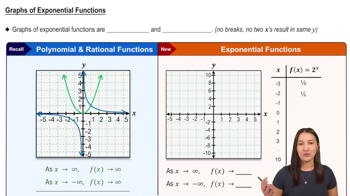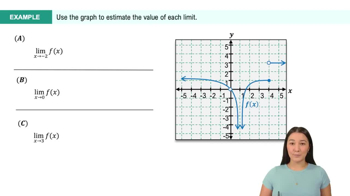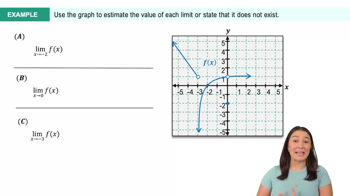Table of contents
- 0. Functions7h 52m
- Introduction to Functions16m
- Piecewise Functions10m
- Properties of Functions9m
- Common Functions1h 8m
- Transformations5m
- Combining Functions27m
- Exponent rules32m
- Exponential Functions28m
- Logarithmic Functions24m
- Properties of Logarithms34m
- Exponential & Logarithmic Equations35m
- Introduction to Trigonometric Functions38m
- Graphs of Trigonometric Functions44m
- Trigonometric Identities47m
- Inverse Trigonometric Functions48m
- 1. Limits and Continuity2h 2m
- 2. Intro to Derivatives1h 33m
- 3. Techniques of Differentiation3h 18m
- 4. Applications of Derivatives2h 38m
- 5. Graphical Applications of Derivatives6h 2m
- 6. Derivatives of Inverse, Exponential, & Logarithmic Functions2h 37m
- 7. Antiderivatives & Indefinite Integrals1h 26m
- 8. Definite Integrals4h 44m
- 9. Graphical Applications of Integrals2h 27m
- 10. Physics Applications of Integrals 2h 22m
1. Limits and Continuity
Introduction to Limits
Problem 2.7.58
Textbook Question
Use the definitions given in Exercise 57 to prove the following infinite limits.
lim x→1^+ 1 /1 − x=−∞
 Verified step by step guidance
Verified step by step guidance1
Understand the problem: We need to prove that as x approaches 1 from the right (x → 1^+), the expression 1/(1-x) approaches negative infinity.
Consider the behavior of the denominator (1-x) as x approaches 1 from the right. Since x is slightly greater than 1, (1-x) becomes a small negative number.
Analyze the fraction 1/(1-x): As (1-x) becomes a small negative number, the fraction 1/(1-x) becomes a large negative number because dividing by a small negative number results in a large negative value.
Formalize the limit: For any large negative number M, we need to find a δ > 0 such that for all x satisfying 0 < x - 1 < δ, the inequality 1/(1-x) < M holds true.
Conclude the proof: By choosing δ = 1 - (1/M), we ensure that as x approaches 1 from the right, 1/(1-x) becomes less than any large negative number M, thus proving the limit is negative infinity.
 Verified video answer for a similar problem:
Verified video answer for a similar problem:This video solution was recommended by our tutors as helpful for the problem above
Video duration:
5mPlay a video:
Was this helpful?
Key Concepts
Here are the essential concepts you must grasp in order to answer the question correctly.
Infinite Limits
Infinite limits describe the behavior of a function as it approaches a certain point, where the function's value increases or decreases without bound. In this case, as x approaches 1 from the right (1+), the function 1/(1-x) tends toward negative infinity, indicating that the values of the function decrease indefinitely.
Recommended video:

One-Sided Limits
One-Sided Limits
One-sided limits focus on the behavior of a function as it approaches a specific point from one direction only. The notation lim x→1^+ indicates that we are considering values of x that are greater than 1, which is crucial for understanding how the function behaves as it nears the point of interest from the right side.
Recommended video:

One-Sided Limits
Understanding the Function's Behavior
To analyze the limit lim x→1^+ 1/(1-x), it is essential to understand how the denominator behaves as x approaches 1 from the right. As x gets closer to 1, 1-x approaches 0, causing the fraction to grow larger in magnitude and negative, leading to the conclusion that the limit is negative infinity.
Recommended video:

Graphs of Exponential Functions

 6:47m
6:47mWatch next
Master Finding Limits Numerically and Graphically with a bite sized video explanation from Callie
Start learning




